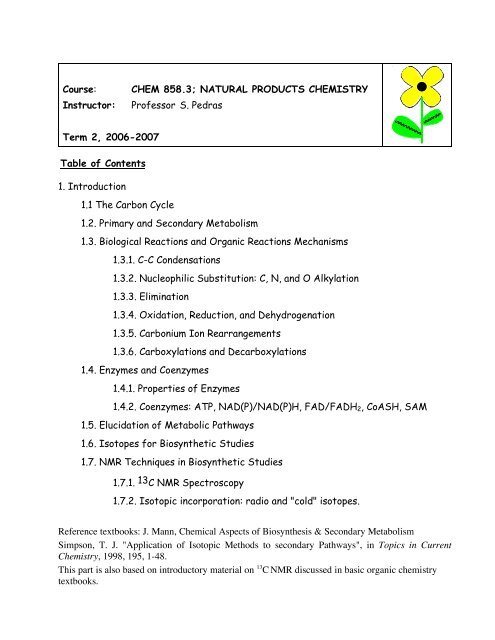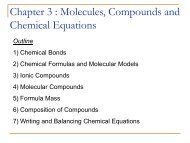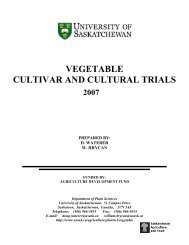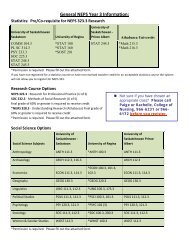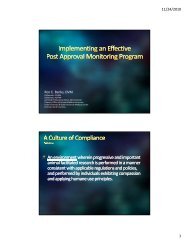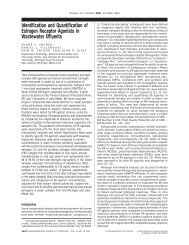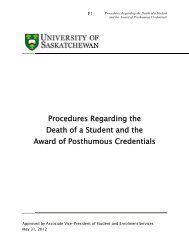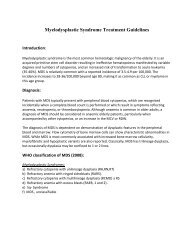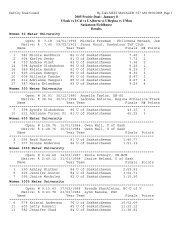Course: CHEM 858.3; NATURAL PRODUCTS CHEMISTRY Instructor
Course: CHEM 858.3; NATURAL PRODUCTS CHEMISTRY Instructor
Course: CHEM 858.3; NATURAL PRODUCTS CHEMISTRY Instructor
You also want an ePaper? Increase the reach of your titles
YUMPU automatically turns print PDFs into web optimized ePapers that Google loves.
<strong>Course</strong>: <strong>CHEM</strong> <strong>858.3</strong>; <strong>NATURAL</strong> <strong>PRODUCTS</strong> <strong>CHEM</strong>ISTRY<br />
<strong>Instructor</strong>: Professor S. Pedras<br />
Term 2, 2006-2007<br />
Table of Contents<br />
1. Introduction<br />
1.1 The Carbon Cycle<br />
1.2. Primary and Secondary Metabolism<br />
1.3. Biological Reactions and Organic Reactions Mechanisms<br />
1.3.1. C-C Condensations<br />
1.3.2. Nucleophilic Substitution: C, N, and O Alkylation<br />
1.3.3. Elimination<br />
1.3.4. Oxidation, Reduction, and Dehydrogenation<br />
1.3.5. Carbonium Ion Rearrangements<br />
1.3.6. Carboxylations and Decarboxylations<br />
1.4. Enzymes and Coenzymes<br />
1.4.1. Properties of Enzymes<br />
1.4.2. Coenzymes: ATP, NAD(P)/NAD(P)H, FAD/FADH2, CoASH, SAM<br />
1.5. Elucidation of Metabolic Pathways<br />
1.6. Isotopes for Biosynthetic Studies<br />
1.7. NMR Techniques in Biosynthetic Studies<br />
1.7.1. 13 C NMR Spectroscopy<br />
1.7.2. Isotopic incorporation: radio and "cold" isotopes.<br />
Reference textbooks: J. Mann, Chemical Aspects of Biosynthesis & Secondary Metabolism<br />
Simpson, T. J. "Application of Isotopic Methods to secondary Pathways", in Topics in Current<br />
Chemistry, 1998, 195, 1-48.<br />
This part is also based on introductory material on 13 C NMR discussed in basic organic chemistry<br />
textbooks.
Chem <strong>858.3</strong> 2006-2007<br />
<strong>Instructor</strong>: Prof. S. Pedras<br />
2. Chemical Ecology and Isolation and Structure Determination of Natural Products<br />
2.1 Introduction<br />
2.2. Animal-Animal Interactions<br />
2.2.1. Sequestration of Plant Toxins<br />
2.2.2. Chemical Defenses<br />
2.3. Plant-Animal Interactions<br />
2.3.1. Constitutive and Induced Defenses<br />
2.4. Plant-Plant Interactions<br />
2.4.1. Allelopathy<br />
2.4.2. Plant-Parasite Interactions<br />
2.5. Plant-Microbe Interactions<br />
2.5.1. Constitutive and Induced Defenses (Phytoalexins)<br />
2.5.2. Mycotoxins and Phytotoxins<br />
2.6. Bioassay-Directed Isolation of Natural Products<br />
2.7. Overview of Spectroscopic Methods for Structure Determination<br />
Chemical Ecology topics will be based on presentations given by students.<br />
Reference textbook: J. Mann, Chemical Aspects of Biosynthesis & Secondary Metabolism pp 81-87<br />
J. B. Harborne, Natural Product Reports: 1986 pp 323-344; 1989 pp 85-109; 1993, 327-348; 1997,<br />
pp 83-98; 2001, pp. 361-379.<br />
For a good REVIEW of Separation methods see: A. Marston & K. Hostettmann, Natural Product<br />
Reports, 391-413 (1991).<br />
2
Chem <strong>858.3</strong> 2006-2007<br />
<strong>Instructor</strong>: Prof. S. Pedras<br />
3. The Polyketide Pathway<br />
3.1. Introduction<br />
3.2. Fatty Acids<br />
3.2.1. Saturated<br />
3.2.2. Unsaturated<br />
3.2.3. β-Oxidation<br />
3.3. Prostanoids and Leukotrienes<br />
3.4. Cyclization of Polyketides to Aromatics<br />
3.5. Skeletal Types of Polyketides<br />
3.5.1. Oxidative Coupling of Phenols<br />
3.5.2. Oxidative Cleavage of Aromatic Rings<br />
3.5.3. Polyketides Having Four C2 to Nine C2 Units<br />
3.6. Macrocyclic Antibiotics<br />
3.7. Halogen Compounds<br />
3.8. Hybrid Antibiotics<br />
Reference textbooks: J. Mann, Chemical Aspects of Biosynthesis & Secondary Metabolism; P. M.<br />
Dewick, “Medicinal Natural Products, A Biosynthetic Approach”.<br />
Reviews on Polyketide Biosynthesis:<br />
B. J. Rawlings, Natural Product Reports, 523-556 (1997).<br />
L. Katz & S. Donadio, Annu. Rev. Microbiol. 47, 875-912 (1993).<br />
McDaniel et al., Nature, 375, 549-554 (1995).<br />
"Comprehensive Natural Products Chemistry" 1999.<br />
3
Chem <strong>858.3</strong> 2006-2007<br />
<strong>Instructor</strong>: Prof. S. Pedras<br />
4. Isoprenoids<br />
4.1. Introduction<br />
4.2. Biosynthesis of Mevalonic Acid and 1-Deoxy-D-Xylulose-5-Phosphate: the C5<br />
Unit<br />
4.3. Monoterpenes<br />
4.3.1. Geranyl Pyrophosphate, Neryl Pyrophosphate, and Linalyl<br />
Pyrophosphate<br />
4.3.2. Iridoids<br />
4.4. Sesquiterpenes<br />
4.4.1. Farnesyl Pyrophosphate<br />
4.4.2. Acyclic Sesquiterpenes<br />
4.4.3. Cyclic Sesquiterpenes<br />
4.5. Diterpenes<br />
4.5.1. Geranyl Geranyl Pyrophosphate and Geranyl Linalyl Pyrophosphate<br />
4.6. Sesterterpenes<br />
4.7. Triterpenes and Steroids<br />
4.7.1. Biosynthesis<br />
4.7.2. Biological Functions of Steroids<br />
4.7.3. Metabolism of Steroids in Plants, Algae and Fungi<br />
4.7.4. Metabolism of Sterols in Mammals: Steroid Hormones and Bile<br />
Acids<br />
4.8. Tetraterpenes<br />
4.8.1. Carotenoids<br />
Reference textbook: J. Mann, Secondary Metabolism, pp. 95-171; Chemical Aspects of<br />
Biosynthesis, pp 31-52; P. M. Dewick, “Medicinal Natural Products, A Biosynthetic Approach”.<br />
"Comprehensive Natural Products Chemistry" 1999, Rohmer, M. vol. 1, pp 45-68; Arigoni, D. vol.<br />
2, 367-399.<br />
Rohdich, F.; Kis, K.; Bacher, A.; Eisenreich, W. The non-mevalonate pathway of isoprenoids: genes,<br />
enzymes and intermediates. Current Opinion in Chemical Biology (2001), 5(5), 535-540.<br />
Lichtenthaler, H. K. Non-mevalonate isoprenoid biosynthesis: Enzymes, genes and inhibitors.<br />
Biochemical Society Transactions (2000), 28(6), 785-789.<br />
4
Chem <strong>858.3</strong> 2006-2007<br />
<strong>Instructor</strong>: Prof. S. Pedras<br />
5. The Shikimic Acid Pathway<br />
5.1. Outline of Shikimic Acid Pathway<br />
5.2. Biosynthesis of Shikimic Acid<br />
5.3. Biosynthesis of Aromatic Amino Acids<br />
5.4. The Phenylpropanoid Metabolism<br />
5.5. Other Metabolites from the Shikimate Pathway<br />
Reference textbook: J. Mann, Secondary Metabolism, pp. 173-190; Chemical Aspects of<br />
Biosynthesis, pp. 53-61; P. M. Dewick, “Medicinal Natural Products, A Biosynthetic Approach”.<br />
P.M. Dewick, The biosynthesis of Shikimate Metabolites, Natural Product Reports, 1992 - 1996;<br />
A.R. Knaggs, idem, 2001, 18, 334; 2003, 20, 119-136.<br />
5
Chem <strong>858.3</strong> 2006-2007<br />
<strong>Instructor</strong>: Prof. S. Pedras<br />
6. The Secondary Metabolism of Amino Acids<br />
6.1. Introduction<br />
6.2. Reactions of Amino Acids Promoted by Pyridoxal Phosphate (PLP)<br />
6.3. Alkaloids<br />
6.3.1. Alkaloids from Metabolism of Ornithine (NC4) and Lysine (NC5)<br />
(pyrrolidine, piperidine, pyrrolizidine, quinolizidine, pyridine)<br />
6.3.2. Alkaloids from Metabolism of Phenyalanine and Tyrosine<br />
(ArC 2N, monocyclic; ArC 2N-R, isoquinolines; ArC 2N-C 2Ar, benzylisoquinolines,<br />
ArC 2N-C 1Ar, amaryllidaceae)<br />
6.3.3. Alkaloids from Metabolism of Tryptophan<br />
6.3.4. Alkaloids from Metabolism of Anthanilic Acid<br />
6.4. Peptides and Depsipeptides<br />
6.5. Penicillines and Cephalosporins<br />
6.6. Cyanogenic Glycosides and Glucosinolates<br />
Reference textbook: J. Mann, Secondary Metabolism, pp. 191-260; Chemical Aspects of<br />
Biosynthesis, pp. 62-80. P. M. Dewick, “Medicinal Natural Products, A Biosynthetic Approach”.<br />
R. B. Herbert, Natural Product Reports, 1988, 5, 523; idem, 1990, 7, 105; idem , 1991, 8, 185; idem,<br />
1992, 9, 507; idem, 1993, 10, 575; idem, 1995, 12, 55; idem, 1996, 13, 45; see also Natural Product<br />
Reports, 1995, 12, 241; idem, 1996, 13, 277.<br />
6
Chem <strong>858.3</strong> 2006-2007<br />
<strong>Instructor</strong>: Prof. S. Pedras<br />
7. Metabolites of Mixed Biosynthetic Origin<br />
7.1. Metabolites Derived from Acetate and Mevalonate<br />
7.2. Metabolites Derived from Shikimate and Mevalonate<br />
7.3. Metabolites Derived from Acetate and Shikimate<br />
7.4. Metabolites Derived from Tryptophan and Mevalonate<br />
Reference textbook: J. Mann, Secondary Metabolism, pp. 261-301; P. M. Dewick, “Medicinal<br />
Natural Products, A Biosynthetic Approach”.<br />
7


